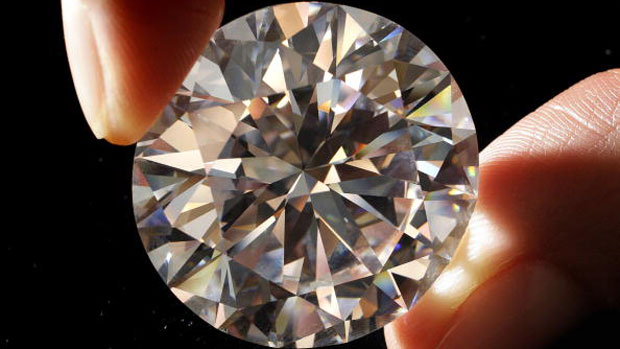Diamonds are sparkling, but would you be a sucker to invest?
Investing in diamonds used to be for experts – or mugs. Now the market is opening up to DIY investors

SOMETHING slightly crazy is going on in China. In what seems to be a topsy-turvy assessment of values, Danone is giving away diamonds to boost sales of powdered milk.
Locals see the French dairy giant’s move as a none-too-subtle ruse to distract attention from the dirt thrown in recent food safety and pricing scandals, but even so, the campaign has sparked widespread interest. You’ve got to admit that, when it comes to choosing what to feed your Little Emperor, the lure of a shiny bauble beats a Mothercare voucher hands down.
Danone’s latest stunt is tapping into an ancient fetish. These sparkly rocks have fascinated humans for millennia, though no-one needs reminding that their cold beauty belies an often bloody past.
The Week
Escape your echo chamber. Get the facts behind the news, plus analysis from multiple perspectives.

Sign up for The Week's Free Newsletters
From our morning news briefing to a weekly Good News Newsletter, get the best of The Week delivered directly to your inbox.
From our morning news briefing to a weekly Good News Newsletter, get the best of The Week delivered directly to your inbox.
As late as the 1990s, 80 per cent of rough diamond sales were in the hands of one company, De Beers, which also controlled half of all production. When the company’s controlling dynasty, the Oppenheimers, sold out – and the discovery of new mines loosened De Beers’ grip on the industry – the market was thrown open. But that, in turn, paved the way for a new army of shysters and con-merchants. A BBC investigation in January uncovered a proliferation of diamond boiler-room scams, with vulnerable targets conned into dodgy schemes often involving non-existent gems.
In fact, investing in diamonds is never straightforward, even when the stones do exist – mainly because valuing them is so tricky. Unlike other precious commodities such as gold, the sheer variety of individual rocks rules out any simple cost-by-ounce pricing mechanism. The basic valuation template boils down to the four Cs – Carat (weight), Colour, Clarity and Cut. But there’s plenty of room for subjective interpretation.
The removal of the De Beers stranglehold has also made prices more volatile. “The industry has been on a rollercoaster ride since the global financial crisis of 2008,” notes the 2013 Global Diamond Report compiled by Bain & Co. Prices plummeted (in part due to distressed selling), “only to rebound to reach historically high levels in 2010 and 2011”. Cue, another mini-crash.
A measure of calm has now returned and, with consumer demand forecast to rebound in key territories like the US, China and India – and supply predicted to contract – the medium-term outlook for sparklers looks strong.
A free daily email with the biggest news stories of the day – and the best features from TheWeek.com
Aficionados will tell you that, for all the vicissitudes of the market cycle, diamonds really are forever. According to Vashi Dominguez of the trader Diamond Manufacturers (aka Vashi.com), “certain types, including coloured varieties [known in the trade as “fancies”] have held had their value over the past few years better than other more volatile equity investments.”
And size counts when it comes to building value. From 1990 to 2011, the value of three-carat diamonds increased by 145 per cent, while five-carat diamonds rose by 171 per cent on the Rapaport Diamond Trade Index (a carat is 0.2 grams).
Colourless (or “white”) diamonds are measured on a sliding colour scale in which the rankings are D (the best blue white) and E (exceptional white). Avoid buying any gem that registers lower than grade H, as it will deemed too yellow. Clarity grades range from Flawless to Imperfect 3. But Dominguez reckons that the most important of the four Cs is “cut”, because it is the skill of the cutter that gives a diamond its brilliance.
Given the level of knowledge involved, some reckon that buying diamonds is a sucker’s game unless you have real expertise – though it’s worth noting that the first rule of buying is to avoid getting shafted by jewellers’ mark-ups. If you want to get a feel for prices, check out the largest online dealer, Rapnet.com.
There are, though, other ways to invest. Because of the difficulty in establishing prices, vehicles like Exchange Traded Funds (common in the gold market) are rare in gems and anyway unregulated. But funds are springing up to track the fortunes of diamond miners and associated companies. The US-based manager PureFunds, for instance, recently launched what it claims is the first “pure-play” diamond industry ETF.
In Britain, Pink Iguana has a tax-efficient Enterprise Investment scheme (EIS) which allows you to invest directly in rare diamonds, provided you’ve a minimum £10,000. Other outfits, such as LinGOLD.com have attempted to broaden the market by trading in “diamond fractions rather than entire stones”. Then, of course, you could always check out individual miners, such as London-listed Petra Diamonds, which has been making the running in terms of exceptional finds of late.
Diamond investment is always going to be risky, but the market fundamentals do look strong. Arguably, the three most important factors in the supply and demand equation are the melting of the De Beers stockpile, a significant decline in the rate at which kimberlites (the host rock for most diamonds) are being discovered, and the growing development of the engagement ring market in new consumer economies like China. Bain reckons these Asian markets will account for 50 percent of incremental global demand by 2020.
Of course, if you’re the kind of market bear who thinks China could become – to quote BBC Business Editor, Robert Peston – the “third wave” of the financial crisis because of the toxic debt in its banks, the demand for celebratory sparklers could fall off a cliff. But arguably that’s where the gems would come into their own as a portable store of value amid turbulence. So look at diamonds as an each way bet.
As Zsa Zsa Gabor concluded: “I never hated a man enough to give him his diamonds back.”
A version of this article appears in the 1 March 2014 edition of The Week
writes profiles for Money Week and is City editor of The Week.
-
 What is the global intifada?
What is the global intifada?The Explainer Police have arrested two people over controversial ‘globalise the intifada’ chants
-
 The Week Unwrapped: What’s the cost of PFAs?
The Week Unwrapped: What’s the cost of PFAs?Podcast Plus why is George Osborne joining OpenAI? And has universal basic income finally come of age?
-
 The week’s best photos
The week’s best photosIn Pictures A dervish dance off, a frosty forest, and more